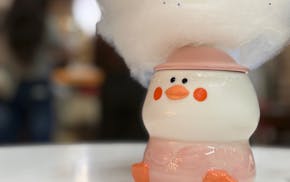Eager to add more native plants to your landscape but worried what the neighbors will say? It's easier than you think to grow these beneficial plants while keeping everyone happy.
Many people associate native plants with grasslands and worry that these indigenous species will appear wispy, even weedy. Nowadays lots of plants have been bred to produce bigger, brighter flowers and grow in consistent shapes and we've become jaded to the subtle beauty of natives.
There are ways to help native plants compensate, says Mary Phillips, a native plant expert and head of the National Wildlife Federation's educational arm Garden for Wildlife. She recommends grouping plants together, such as clustering flowers with native grasses, for bold impact. These larger clusters will also be more visible to birds and butterflies.
"Good design is important. It will help frame the features of a garden and provide a neat appearance that neighbors will appreciate," Phillips says.
If you live on an acreage, it might not be as much of a concern. But here in the cities where folks like me live shoulder-to-shoulder on smaller urban lots, we are up in each other's business, and everybody has a different idea of what makes for a lovely landscape.
Other things to keep in mind when maintaining a native plant garden:
Maintain regularly
Going wild doesn't mean letting things go. You've probably seen yards where good intentions have gotten away from the homeowners. Promise to tend your plot.
Communicate with neighbors
And whether you plan to include just a few or fill the whole yard, it helps to do a little pre-emptive public relations, too. This is especially important if you're dealing with a neighborhood association. Benjamin Vogt, urban prairie designer and author of the upcoming book, "Prairie Up: An Introduction to Natural Garden Design," stressed the importance of communicating with others.
"The key to working with a [homeowners association] is to present an actual planting plan while addressing the management strategies for the space, a list of plants and their environmental benefits is a plus, along with images of those plants and inspirational gardens," he says.
Let your neighbors know about your planting projects. Explain the benefits of native plants — no fertilizer or pesticide is needed and, because wildlife are adapted to these plants, they'll enjoy more bees, butterflies and birds from such efforts.
Leave some lawn
Well defined boundaries between plant-rich borders and a small swoop of lawn help identify it as a garden. And, while more and more people are anxious to do away with their lawns, leaving some lawn — even a narrow strip of mown grass by or around a natural landscape — can give what is called a "cue to care," letting the observer know that there is intention behind the plantings. Over half of my city yard is planted with natives and this strategy has worked well for me.
Consider pretty, shade-tolerant natives
Not all natives are sun-seekers. Take the shade-dappled vignette in my garden; ginger with its heart-shaped leaves acts as a groundcover under the pagoda dogwood tree (a native, too) while in the spring the pretty blue flowers of Jacob's ladder and Virginia bluebells mingle through it. White violets and wild strawberries grow here and there.
In another area that stays moister than the rest of the yard, Virginia waterleaf (bees love to peruse the pale lavender flowers), oak sedge and interrupted fern grow beneath serviceberries, birch trees and red-twig dogwood shrubs.
'Edit' as you go
As plantings mature, I appreciate when they spread and become living mulch that suppresses weeds and supports other wildlife. If the plantings leap the bounds of any borders, I pull or "edit" them from places I don't want them. Natives reproduce by underground rhizomes or seed. Some do both.
In my sunny front yard, common milkweed "walks" around to where it's happiest, but I don't mind. I like to see the ebb and flow of plants; I don't want a static garden.
Consider spacing and other needs
However, not every native plant is suited for smaller gardens; sometimes they are mistakenly called invasive simply for being successful. True invasives are non-native plants that displace native plants, threaten humans or livestock or disrupt entire ecosystems.
I'll confess to planting ostrich ferns in a tight spot where the gorgeous specimens quickly took over the entire space. Not the plant's fault for thriving. They needed a bigger area, lesson learned.
Before you plant, do your homework. Consider the light, soil and moisture needs of a particular plant. What type of situation is the plant native to — woodland, prairie, water's edge?
Personalize your garden
Simply placing an item that reminds people of the human behind the garden makes a wilder landscape more acceptable, and once again shows intention. Garden art, sculpture, birdbath or other décor are great ways to express your creative side while accomplishing this. A bench or chair is an inviting way to signal yet another cue to care.
Put a sign on it
Native plantings in neighborhoods are there for everyone's enjoyment, but they educate, too. A sign explaining your planting goals or purpose helps with that mission.
It's easy to apply for official designations, such as Certified Backyard Habitat from the National Wildlife Federation or Monarch Waystation from Monarch Watch. You can get a Pollinator Café sign free from the University of Minnesota.
Homemade signs work just as well. I collect 'em all and have to rotate them one at a time! It's satisfying to see passersby stop and check out the blooms, bees and butterflies when they walk past our house.
And so far, nobody's complaining.
Rhonda Hayes is a Twin Cities-based Extension Master Gardener, writer and author of "Pollinator Friendly Gardening."

The 5 best things our food writers ate this week

A Minnesota field guide to snow shovels: Which one's best?

Summer Camp Guide: Find your best ones here

Lowertown St. Paul losing another restaurant as Dark Horse announces closing

